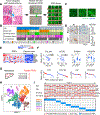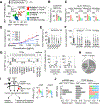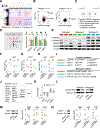Three subtypes of lung cancer fibroblasts define distinct therapeutic paradigms
- PMID: 34624218
- PMCID: PMC8578451
- DOI: 10.1016/j.ccell.2021.09.003
Three subtypes of lung cancer fibroblasts define distinct therapeutic paradigms
Abstract
Cancer-associated fibroblasts (CAFs) are highly heterogeneous. With the lack of a comprehensive understanding of CAFs' functional distinctions, it remains unclear how cancer treatments could be personalized based on CAFs in a patient's tumor. We have established a living biobank of CAFs derived from biopsies of patients' non-small lung cancer (NSCLC) that encompasses a broad molecular spectrum of CAFs in clinical NSCLC. By functionally interrogating CAF heterogeneity using the same therapeutics received by patients, we identify three functional subtypes: (1) robustly protective of cancers and highly expressing HGF and FGF7; (2) moderately protective of cancers and highly expressing FGF7; and (3) those providing minimal protection. These functional differences among CAFs are governed by their intrinsic TGF-β signaling, which suppresses HGF and FGF7 expression. This CAF functional classification correlates with patients' clinical response to targeted therapies and also associates with the tumor immune microenvironment, therefore providing an avenue to guide personalized treatment.
Keywords: cancer therapy; cancer-associated fibroblasts; lung cancer; patient-derived models; personalized medicine; resistance; targeted therapy; tumor heterogeneity; tumor microenvironment; tumor-infiltrating lymphocytes.
Copyright © 2021 The Authors. Published by Elsevier Inc. All rights reserved.
Conflict of interest statement
Declaration of interests Z.P. receives commercial research support from Novartis, Tesaro, Spectrum, AstraZeneca, and Takeda; and serves as a consultant/advisory board member for AstraZeneca, Takeda, Novartis, ImmunoGen, Guardant Health, and Spectrum. L.V.S. serves as a compensated consultant or received honoraria from AstraZeneca, Janssen, Merrimack, and Genentech; and receives institutional research funding from AstraZeneca, Boehringer Ingelheim, Novartis, Genentech, Merrimack, Blueprint Medicines, and LOXO. C.H.B.’s laboratory received support for research from Novartis, Amgen, and Araxes. A.T.S. is an employee of Novartis and a paid consultant for Pfizer, Genentech/Roche, Ariad/Takeda, Syros, Blueprint Medicine, KSQ Therapeutics, TP Therapeutics, Chugai, Daiichi-Sankyo, LOXO/Bayer, Achilles, Archer, Foundation Medicine, and Guardant. M.M.-K. serves as a consultant for Merrimack Pharmaceuticals and H3 Biomedicine. A.N.H. receives commercial research grants from Amgen, Novartis, Relay Therapeutics, Pfizer, and Roche/Genentech. R.S.H. receives consulting honoraria from Boehringer Ingelheim, Tarveda, and Apollomics; and receives institutional research funding from Daichii Sankyo, Agios, Novartis, Corvus, Mirati, Genentech Roche, Incyte, Abbvie, Celgene, and Exelixis. L.P. has financial interests in Edilytics. L.P.’s interests were reviewed and are managed by Massachusetts General Hospital and Partners Health Care in accordance with their conflict-of-interest policies. J.J.W., Y.-Q.M., and R.-P.H. are employees of RayBiotech Inc. M.J.N. is a Novartis employee and equity holder. D.P.K., C.H.B., and J.A.E. are Novartis employees (contribution at Massachusetts General Hospital). The other authors declare no competing interests.
Figures








References
-
- Bartoschek M, Oskolkov N, Bocci M, Lövrot J, Larsson C, Sommarin M, Madsen CD, Lindgren D, Pekar G, Karlsson G, Ringnér M, Bergh J, Björklund Å, Pietras K, 2018. Spatially and functionally distinct subclasses of breast cancer-associated fibroblasts revealed by single cell RNA sequencing. Nat Commun 9, 5150. - PMC - PubMed
-
- Bhowmick NA, Chytil A, Plieth D, Gorska AE, Dumont N, Shappell S, Washington MK, Neilson EG, Moses HL, 2004. TGF-beta signaling in fibroblasts modulates the oncogenic potential of adjacent epithelia. Science 303, 848–851. - PubMed
-
- Blomme A, Van Simaeys G, Doumont G, Costanza B, Bellier J, Otaka Y, Sherer F, Lovinfosse P, Boutry S, Palacios AP, De Pauw E, Hirano T, Yokobori T, Hustinx R, Bellahcène A, Delvenne P, Detry O, Goldman S, Nishiyama M, Castronovo V, Turtoi A, 2018. Murine stroma adopts a human-like metabolic phenotype in the PDX model of colorectal cancer and liver metastases. Oncogene 37, 1237–1250. - PubMed
-
- Blondel VD, Guillaume J-L, Lambiotte R, Lefebvre E, 2008. Fast unfolding of communities in large networks. J. Stat. Mech 2008, P10008.
Publication types
MeSH terms
Substances
Grants and funding
LinkOut - more resources
Full Text Sources
Medical

